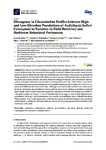Divergence in Glucosinolate Profiles between High- and Low-Elevation Populations of Arabidopsis halleri Correspond to Variation in Field Herbivory and Herbivore Behavioral Preferences
| dc.contributor.author | Buckley, J | |
| dc.contributor.author | Pashalidou, FG | |
| dc.contributor.author | Fischer, MC | |
| dc.contributor.author | Widmer, A | |
| dc.contributor.author | Mescher, MC | |
| dc.contributor.author | De Moraes, CM | |
| dc.date.accessioned | 2020-09-15T08:22:03Z | |
| dc.date.issued | 2019 | |
| dc.identifier.issn | 1422-0067 | |
| dc.identifier.issn | 1422-0067 | |
| dc.identifier.other | 174 | |
| dc.identifier.uri | http://hdl.handle.net/10026.1/16281 | |
| dc.description.abstract |
<jats:p>Variation in local herbivore pressure along elevation gradients is predicted to drive variation in plant defense traits. Yet, the extent of intraspecific variation in defense investment along elevation gradients, and its effects on both herbivore preference and performance, remain relatively unexplored. Using populations of Arabidopsis halleri (Brassicaceae) occurring at different elevations in the Alps, we tested for associations between elevation, herbivore damage in the field, and constitutive chemical defense traits (glucosinolates) assayed under common-garden conditions. Additionally, we examined the feeding preferences and performance of a specialist herbivore, the butterfly Pieris brassicae, on plants from different elevations in the Alps. Although we found no effect of elevation on the overall levels of constitutive glucosinolates in leaves, relative amounts of indole glucosinolates increased significantly with elevation and were negatively correlated with herbivore damage in the field. In oviposition preference assays, P. brassicae females laid fewer eggs on plants from high-elevation populations, although larval performance was similar on populations from different elevations. Taken together, these results support the prediction that species distributed along elevation gradients exhibit genetic variation in chemical defenses, which can have consequences for interactions with herbivores in the field.</jats:p> | |
| dc.format.extent | 174-174 | |
| dc.format.medium | Electronic | |
| dc.language | en | |
| dc.language.iso | en | |
| dc.publisher | MDPI AG | |
| dc.subject | preference | |
| dc.subject | performance | |
| dc.subject | defense | |
| dc.subject | glucosinolate | |
| dc.subject | elevation | |
| dc.subject | altitude | |
| dc.subject | herbivore | |
| dc.subject | oviposition | |
| dc.subject | Pieris brassicae | |
| dc.subject | Arabidopsis halleri | |
| dc.title | Divergence in Glucosinolate Profiles between High- and Low-Elevation Populations of Arabidopsis halleri Correspond to Variation in Field Herbivory and Herbivore Behavioral Preferences | |
| dc.type | journal-article | |
| dc.type | Article | |
| plymouth.author-url | https://www.ncbi.nlm.nih.gov/pubmed/30621284 | |
| plymouth.issue | 1 | |
| plymouth.volume | 20 | |
| plymouth.publication-status | Published online | |
| plymouth.journal | International Journal of Molecular Sciences | |
| dc.identifier.doi | 10.3390/ijms20010174 | |
| plymouth.organisational-group | /Plymouth | |
| plymouth.organisational-group | /Plymouth/Faculty of Science and Engineering | |
| plymouth.organisational-group | /Plymouth/Faculty of Science and Engineering/School of Biological and Marine Sciences | |
| plymouth.organisational-group | /Plymouth/REF 2021 Researchers by UoA | |
| plymouth.organisational-group | /Plymouth/REF 2021 Researchers by UoA/UoA06 Agriculture, Veterinary and Food Science | |
| plymouth.organisational-group | /Plymouth/REF 2021 Researchers by UoA/UoA06 Agriculture, Veterinary and Food Science/UoA06 Agriculture, Veterinary and Food Science MANUAL | |
| plymouth.organisational-group | /Plymouth/Users by role | |
| plymouth.organisational-group | /Plymouth/Users by role/Academics | |
| dc.publisher.place | Switzerland | |
| dcterms.dateAccepted | 2018-12-28 | |
| dc.rights.embargodate | 2023-8-16 | |
| dc.identifier.eissn | 1422-0067 | |
| dc.rights.embargoperiod | Not known | |
| rioxxterms.versionofrecord | 10.3390/ijms20010174 | |
| rioxxterms.licenseref.uri | http://www.rioxx.net/licenses/all-rights-reserved | |
| rioxxterms.type | Journal Article/Review |


